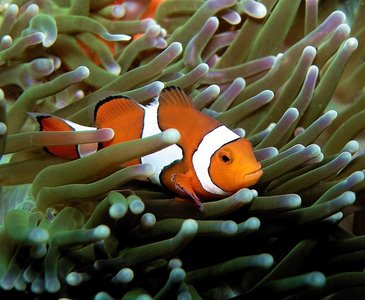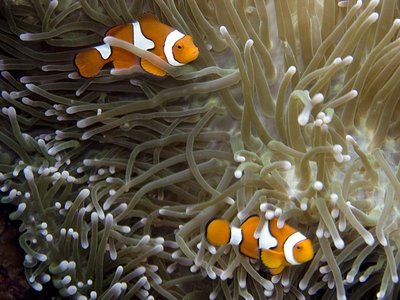
© clownfishmichaela2
Clownfish were popularized as aquarium pets by the recent Pixar movie,
Finding Nemo. Clownfish are recognized by their orange scales with black
and white stripes.
There was a family of clownfish that lived in the sea,
They lived in an anemone!
Too soon, their children started to mature,
Time to find their own homes, for sure.
One of these clownfish, the littlest one,
Was named Jess, and she loved to have fun;
Out she swam to find a place,
She thought it’d be easy, but that was not the case.
The first anemone she found,
There were lots of other fish around;
“Get out of here,” an older one said,
Scared, little Jess swam on ahead.


Amphiprion percula. © Jan Messersmith. This is a picture of a clownfish and its host anemone. Clownfish form a symbiotic relationship with their anemones; they help each other survive. Clownfish produce a special mucous coating that protects them from the anemone's poisonous, stinging tentacles.
The next anemone, her brother saw too,
“I’ll fight you for it, through and through,”
But, it was no use, because her brother was stronger,
So Jess swam on a little longer.
She saw three more living spaces,
But each of these had eggs at the bases;
“I can’t live here!” said Jess with a sigh,
And so she swam on, but started to cry.
She sighed and she cried, and she said to herself,
“Oh no” but a fish was approaching with stealth;
This fish, he was starving, and he saw her bright scales,
He wanted a meal, and his hunger prevailed.
Smart Jess saw him coming, and she swam away,
But this fish was convinced she was the catch of the day;
As they ducked through the coral, on the reef that was home,
She hid under a rock, in underwater loam.
Then, all of a sudden, Jess saw a great thing!
An anemone, named Annie, who would happily sting
The big fish that was chasing her all through the water.
Jess thought her dad would be proud of his daughter.
“Hi I’m Annie,” the anemone said,
“Stay with me, if you need a bed.”
“That’s great” exclaimed Jess, with a sigh of relief,
“I’ll have my own place on the ol’ coral reef!”
So Jess moved in to her new home, everything was great,
But something was missing; a male clownfish mate!
One fateful day, Cameron the Clownfish came by,
Jess thought he was handsome, and went to say hi.
The two young clownfish moved in together.
They stuck by each other through all types of weather.
5 days later, their babies were born; they were very small,
Jess was so happy—she had it all!
View pictures of clownfish eggs. Clownfish eggs take between 5 and 7 days to hatch. They are laid at the base of the host anemone for protection.
But all too soon, the fish were too big to play,
And one by one, they moved away;
They found their own anemones,
And lived out their days swimming in the seas!
The cycle continues, but our story ends here,
Everyone lived happily ever after, never fear;
And Jess was a happy fish with all of her friends,
There is no more, this is the end!


Amphiprion percula. © Jan Messersmith.
Information on the Internet
- Clownfish
- Percula Clownfish This website is moderately more detailed.
- Amphiprion percula
- Clownfish This page has a few more facts on clownfish.
- More Information on Clownfish



 Go to quick links
Go to quick search
Go to navigation for this section of the ToL site
Go to detailed links for the ToL site
Go to quick links
Go to quick search
Go to navigation for this section of the ToL site
Go to detailed links for the ToL site